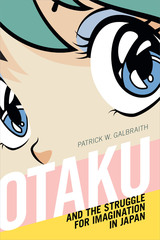
Japanese comics, commonly known as manga, are a global sensation. Critics, scholars, and everyday readers have often viewed this artform through an Orientalist framework, treating manga as the exotic antithesis to American and European comics. In reality, the history of manga is deeply intertwined with Japan’s avid importation of Western technology and popular culture in the early twentieth century.
Comics and the Origins of Manga reveals how popular U.S. comics characters like Jiggs and Maggie, the Katzenjammer Kids, Felix the Cat, and Popeye achieved immense fame in Japan during the 1920s and 1930s. Modern comics had earlier developed in the United States in response to new technologies like motion pictures and sound recording, which revolutionized visual storytelling by prompting the invention of devices like speed lines and speech balloons. As audiovisual entertainment like movies and record players spread through Japan, comics followed suit. Their immediate popularity quickly encouraged Japanese editors and cartoonists to enthusiastically embrace the foreign medium and make it their own, paving the way for manga as we know it today.
By challenging the conventional wisdom that manga evolved from centuries of prior Japanese art and explaining why manga and other comics around the world share the same origin story, Comics and the Origins of Manga offers a new understanding of this increasingly influential artform.


Manga from the Floating World is the first full-length study in English of the kibyôshi, a genre of sophisticated pictorial fiction widely read in late-eighteenth-century Japan. By combining analysis of the socioeconomic and historical milieus in which the genre was produced and consumed with three annotated translations of works by major author-artist Santô Kyôden (1761-1816) that closely reproduce the experience of encountering the originals, Adam Kern offers a sustained close reading of the vibrant popular imagination of the mid-Edo period. The kibyôshi, Kern argues, became an influential form of political satire that seemed poised to transform the uniquely Edoesque brand of urban commoner culture into something more, perhaps even a national culture, until the shogunal government intervened.
Based on extensive research using primary sources in their original Edo editions, the volume is copiously illustrated with rare prints from Japanese archival collections. It serves as an introduction not only to the kibyôshi but also to the genre's readers and critics, narratological conventions, modes of visuality, format, and relationship to the modern Japanese comicbook (manga) and to the popular literature and wit of Edo. Filled with graphic puns and caricatures, these entertaining works will appeal to the general reader as well as to the more experienced student of Japanese cultural history.

Manga from the Floating World is the first full-length study in English of the kibyōshi, a genre of woodblock-printed comic book widely read in late-eighteenth-century Japan. By combining analysis of the socioeconomic and historical milieus in which the genre was produced and consumed with three annotated translations of works by major author-artist Santō Kyōden (1761–1816) that closely reproduce the experience of encountering the originals, Adam Kern offers a sustained close reading of the vibrant popular imagination of the mid-Edo period. The kibyōshi, Kern argues, became an influential form of political satire that seemed poised to transform the uniquely Edoesque brand of urban commoner culture into something more, perhaps even a national culture, until the shogunal government intervened.
Based on extensive research using primary sources in their original Edo editions, the volume is copiously illustrated with rare prints from Japanese archival collections. It serves as an introduction not only to the kibyōshi but also to the genre’s readers and critics, narratological conventions, modes of visuality, format, and relationship to the modern Japanese manga and to the popular literature and wit of Edo. Filled with graphic puns and caricatures, these entertaining works will appeal to the general reader as well as to the more experienced student of Japanese cultural history—and anyone interested in the global history of comics, graphic novels, and manga.

READERS
Browse our collection.
PUBLISHERS
See BiblioVault's publisher services.
STUDENT SERVICES
Files for college accessibility offices.
UChicago Accessibility Resources
home | accessibility | search | about | contact us
BiblioVault ® 2001 - 2024
The University of Chicago Press









